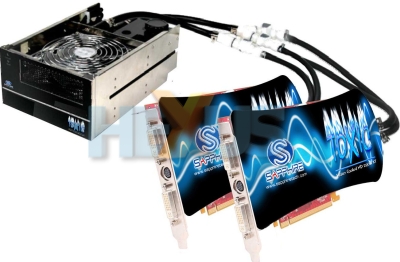Whilst Sapphire's standard HD2900XT solution boasts a core clock speed of 750MHz and memory speeds to the tune of 1650MHz, Sapphire explain that their TOXIC solution will allow for a boost of over 15% in core clock speeds. Memory speeds, they go on to say, can be increased 'significantly' over the stock speeds already mentioned.
The boards ship with 512MB of onboard GDDR3 memory powered by a 512-bit memory bus controller.
The water cooling solution featured as part of the HD 2900 XT TOXIC, comprises of a reservoir, pump and radiator system that have been intelligently incorporated into a drive-bay mountable unit and not only has the power to efficiently cool a system environment powered by one graphics card, but to optionally cool a pair of HD 2900 XT TOXIC cards in CrossFire mode, or even the system processor.
A preview image of two HD 2900XT TOXIC CrossFire cards is seen below and this demonstrates the drive-bay mountable unit, together with the optional facility to cool two TOXIC solutions being depicted.

The R600XT GPU powering Sapphire's iterations is a native Shader Model 4.0 and DirectX 10 graphics processing unit which, as would be expected, is Microsoft Windows Vista Premium Ready.
Two Dual Link DVI outputs are present, together with HDMI support and multi-channel 5.1 audio integrated onboard with the graphics output and allows for true audio and video output via an HDMI adapter, perfect for direct connection to an HDMI ready television.
Sapphire's Full Retail Versions, in addition to the Valve 'Black Box' suite, a common theme amongst the HD2900XT releases from AMD's AIB's, include Cyberlink's PowerDVD and PowerDirector solutions for Windows XP, as well as a Futuremark benchmark CD.
The company go on to state that whilst their standard HD2900XT solution is shipping now, they expect to announce other family members in the coming weeks.
Read the press release in full here.













